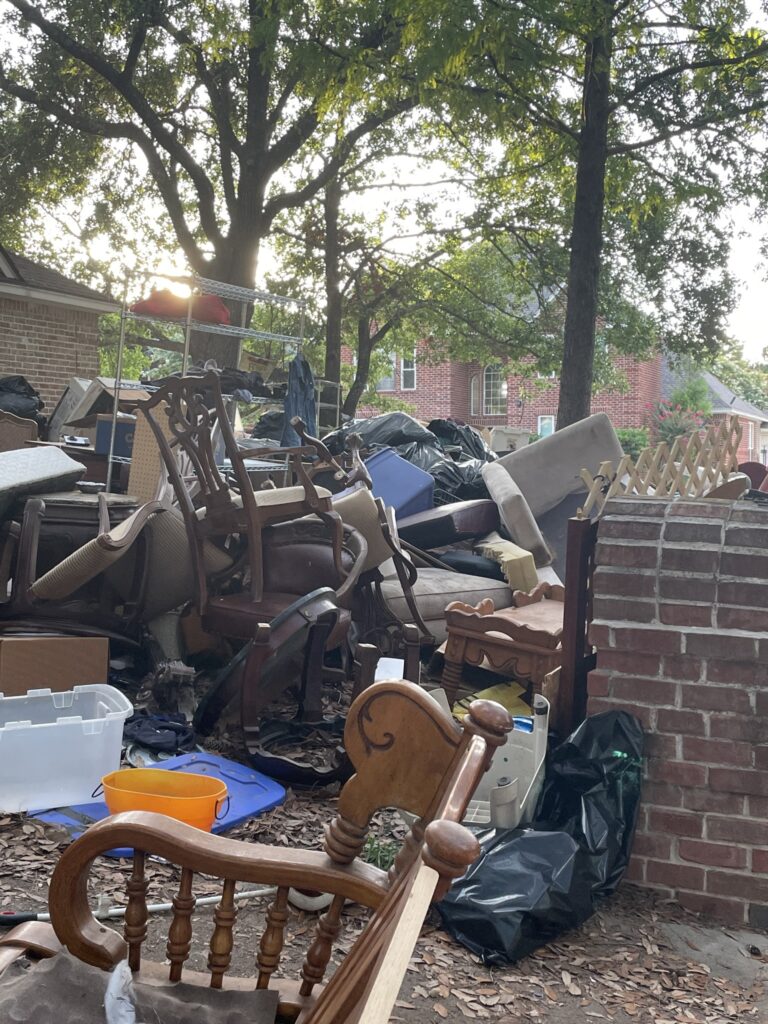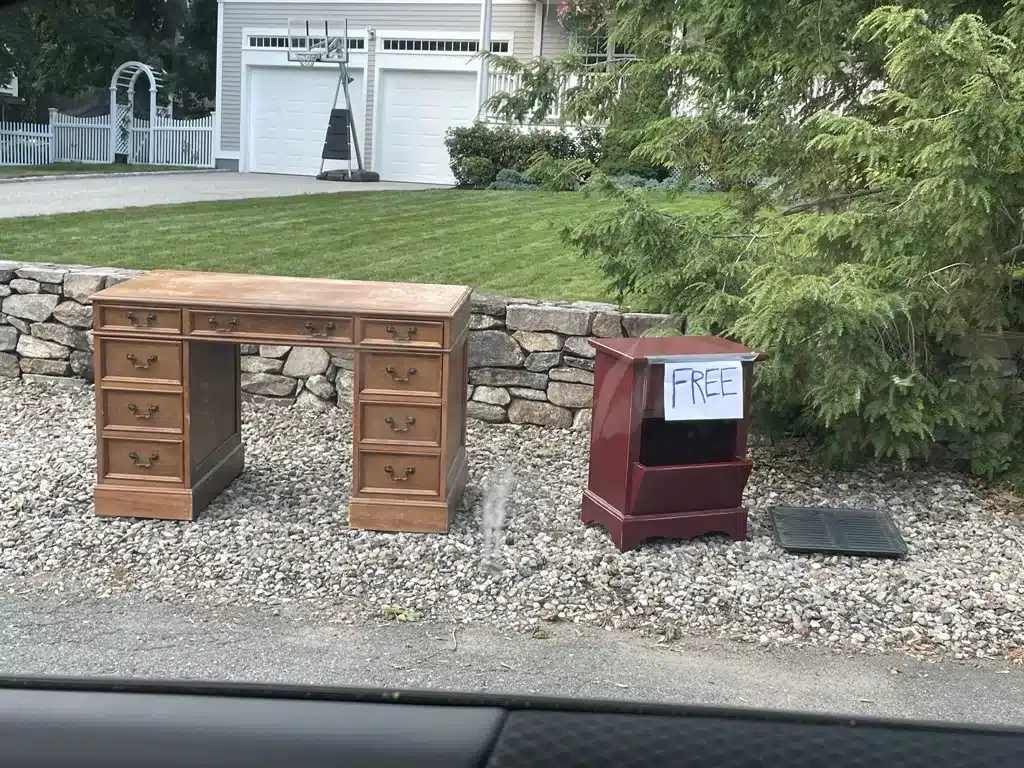This post may contain affiliate links, which means we will receive a commission if you purchase through our link, at no extra cost to you. Please read full disclosure here.
This article is about how to find free furniture and
How many times have you passed an old chair or broken table by the side of the road and slowed down for a closer look? You can find free furniture and
Flipping furniture and room decor items is a fun side hustle for a little extra cash. But what if you want to start a furniture flipping business from nothing? We can tell you that we did–and twelve months later we had a five-figure income. This is even true if you flip thrift items part time (we do). But part of your business strategy needs to include learning how to find furniture and
Eventually, you’ll want to start budgeting for other costs, like your own time finding stuff, gas money, and upcycling costs like paint and sandpaper. But in the beginning, you can literally find free stuff, and resell it with no additional costs. And we used that money to buy supplies and even cover gas money. And, we also used those free
Let’s dive in: Curbside finds and dumpster dives
We’re going to be honest here. We call ourselves “picky pickers” because we are pretty selective about what we get for free off the street. We’ve never climbed into a dumpster (but we LOVE to watch others on TikTok!). If you’re up for that–go for it!

Seriously. All, free. Combined, the items sold totaled more than $500.
But we tend to pick up free furniture, lamps, and
Your dumpster diving (or curbside picking) still needs a strategy. (Yes, seriously.)
A lot of people think pickers and dumpster divers just “get lucky.” But we are HUGE believers that “Luck favors the prepared.” That means you can strategically increase your changes of finding things on the curb. Don’t just jump in the car and drive around randomly, burning through gas as fast as possible. Over time we have learned how to have regular routes, and a schedule. We know where to go and what kinds of things to look for. Sometimes we still come home empty handed. But sometimes we come home three times in one night to empty and go back out (jackpot!).

We found this vintage hotel phone next to a garbage can. It didn’t work but we put it on Facebook Marketplace and it had hundreds of views within hours. It sold a few days later for $100.
Get regular routes that you can drive 2-3 times per week looking for things on the curb. For us, Sunday nights are particularly good because people tend to clean out over the weekend and put bulk trash to the street. Also, if they had a garage sale or moving sale, it’s more likely that they put the rest to the street. Special tip: if we went to a garage sale or moving sale that weekend, we sometimes drive by on Sunday. (Is that creepy? No, we’re just committed.)
Again, we don’t personally do dumpster diving so we won’t offer an opinion here. But like curbside finds, you’re better off deciding a strategy. If we did do it, we would probably go for retail stores, hoping to pick up some inventory that was dumped. But some people go near construction sites for scrap metal. And some like grocery stores for free food dives. Hey, we just hear things.
A word about evictions: free for all the wrong reasons
Our own personal journey to flipping furniture and vintage decor for profit was born out of loving a good deal, holding countless garage sales and loving vintage decor. Every now and then we’d pull over if we saw a really good table or lamp on the curb. But once we started flipping furniture for money, we knew we had to more seriously cruise around for curbside finds. Only when we started looking did we realize just how much Americans toss, that has tons of life left. And real value. We moved from just an opportunity to do something we love for free. We became much more aware of waste in general.

Evictions are awful for everyone. This isn’t the way we want free stuff. It hurts the people and it hurts the planet.
This brings us to evictions. The truth is, it’s hard to see someone else’s life dumped all over the lawn. For a while, we’d pass on by because it felt so vulture-y to pick among the personal items. Then one day we were overwhelmed by the high quality furniture, decor and household items that would be in a dumpster by dark and a landfill after that. We decided there was nothing we could do about the past and whatever led to the eviction. But we could avoid a future where really useful and high quality items could be re-homed. We could make some money. And the planet would have one less hole crammed with human junk in it. It’s a personal choice, and not for everyone. The best we can do is be grateful and not gleeful.
Moving on: moving sales, garage sales and estate sales: go at the end of the sale to get free furniture
Ok, this is free with a caveat. You will probably have to buy something at a garage sale. It’s just awkward to walk up and ask for free stuff. However, there are a couple of ways to get free furniture and
Tip 1: See if you can get something free with purchase.
lf you buy a couple things, and then ask for a deal on a couple more, you can get something for free. Or, we can bundle so much more that basically the additional items are free. We once bought a chair for $8, and the homeowner gave us a storage unit for free. We even bought a Pulaski bar cabinet for $50 at a moving sale, and all of the consumable contents came for free. (Yes, exactly what you think we mean.) Plus, cute bar decor signs, trays to hold glasses, corkscrews and other bar accessories. (We later sold the bar cabinet for $300.) Our family is originally from Louisiana, and lagniappe is the word for a little something extra (for free). When we had garage sales, we always offered a little lagniappe.
Your free with bundle items are usually small, or complementary to what you bought. Like with the bar cabinet, the owner was moving and had no way to take all the contents with them. It was easy to just give it to us. Sometimes it’s not related to what you bought, just books or a few glasses, or knickknacks. But generally, the more you buy (or if you come back multiple times), the better the lagniappe.
Tip 2: Go at the end of the last day.
Maybe you can’t afford to spend $50 on furniture just to get some free glasses. You can still get things for free, or almost free. Again, you probably shouldn’t walk up to the sale and just ask for free stuff. But prices will usually be lower and highly negotiable. You would be shocked at how much you can buy for a dollar at a garage sale, at the end of the day. Just to name a few of our $1 finds: Reebok shoes, Rebecca Minkoff purses, chairs, lamps and more planters and garden decor than you can imagine. So while nothing beats free, you can stretch a dollar or two much further than you realize. And you can still–in a polite and friendly way–ask for free stuff. So in addition to those one to two dollar purchases, you may be able to snag a few free items.
Garage sales, moving sales and estate sales all are great places to get free stuff for your furniture flipping business. The people running the sale are motivated to move stuff, even for free. Otherwise they either have to drag things back into the house (garage sale), or have it hauled away (if it’s a moving sale or estate sale). At this point, they just want it gone. Luckily, you’re there to scoop it up!
Bonus tip: moving sales are the absolute best place to get free furniture. (Even better than garage sales and estate sales.)
A garage sale seller might be just doing a spring clean, and take back inside (or list online) whatever they don’t sell. Professional estate sale companies often have post-sale contracts where they sell what’s left in bulk to an auction house or other third party. Although, we do have tips on how to find estate sale bargains. But moving sales are usually run by people who are highly motivated to offload as much as possible, as quickly as possible. They are under a deadline to clear out their house, they have a limit to how much they can take with them. People will sometimes be happy for you to take what hasn’t sold.
In fact, I used to live in New York where the demand for large items that couldn’t be taken on the subway or stuck in a taxi was low. Seriously, just check out @stoopingnyc to see the amazing free furniture and decor in New York City that people pass by and wish they could take, but can’t. Bonus tip: if you live in the suburbs of a major city where many people rely on public transportation, it might be worth a trip in. Obviously, that takes real commitment, but you will probably have a competitive advantage to pick up stuff, just because you have a car!
Move out day at colleges also can be a great opportunity to get free furniture.
Speaking of moving, it’s worth mentioning that college campuses at the end of the school year can be a treasure trove of free items. Our only issue is that it only happens once or twice a year! Also, you need to live near a decent sized campus. If you have read our other posts about how to build a business flipping furniture and
Online platforms: Facebook Marketplace, Next Door and Craigslist
Even though most people go to online platforms like Marketplace and NextDoor to buy and sell things, there are a lot of things also available for free. You can definitely get free things this way. If you are in a big city you may find there is a lot of competition to get the best stuff. But we ourselves have jumped into a car and rushed to grab a treasure. Our personal favorite is NextDoor because we can filter to neighborhoods close by that we can get to quickly. However, if you have a limited amount of time, these options might not be as practical for free stuff.
You found free stuff: is it treasure, or really just trash?
So now you’ve found something tempting on the curb. At first, you can pick up almost anything. If you get home and decide it’s just beyond the pale, then toss or recycle it. But eventually, you’ll end up stacking up too much stuff that really isn’t worth it. So, some tips when you’re on the curb with the car running and assessing your free find:
- If it can be used as is–pick it up. Sometimes it’s obvious that the item is in decent shape. Maybe there are three good chairs and the fourth one is gone. Or, it’s a scratched table but clearly still usable. As long as it just needs a good cleaning, or maybe two coats of paint, then definitely grab it.
- Can you repair it? Sometimes we have taken a set of chairs, and taken them apart and put the best back together. For example we found a set of chairs. Two had bad seats, one had a broken leg. We took them apart and put the best together so we were left with four good chairs. But don’t invest more time than is worth the ultimate value. In other words, fixing the chairs took about an hour. But the value was much higher so it was worth the time.
- Can you upcycle or use for parts? If you want to upcycle into something else, then it might be ok if it’s broken. You might break it up for parts (yep, like an old car). We have taken home waterlogged lamps just for their harps and finials. We have also taken really broken up particleboard furniture just to use the hardware. Another tip: hairpin legs are very popular, and not cheap. We have tossed crappy table tops for good legs. And, we’ve saved good table tops and put them on new bases. But, again, be sure you aren’t taking on a harder upcycle than is worth your time.
- Special note about IKEA. Did you know that IKEA will send small replacement parts for free? If you happen to find an IKEA chair or table with a loose leg, don’t leave it! If the item hasn’t been retired, you can go on IKEA’s website, and look up the part number and they will send screws, knobs and hinges for free. We found an IKEA table that needed 11 parts and they arrived within a couple of weeks. A free table quickly became a $50 sale!
With a good strategy, you can get free furniture and vintage home decor .
It might seem silly to think that you can learn to get better at finding free stuff. But you really can get smarter about where to look, and when. We get “lucky” more and more often, but if you have a strategy, you don’t need luck. The more often you work at it, learn from your mistakes (and your wins!) and you’ll start to find more too. We know: we have done it for hours and hours. We have learned the best neighborhoods, what to leave behind and what can be upcycled into something else. And now we have made thousands of dollars, thanks to hard work and curbside finds. And you can too. Use secondhand, sell found furniture, and make money. Let’s fill our pockets rather than our planet.
This article is about how to find free furniture and







